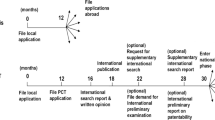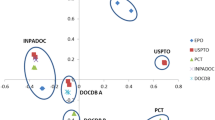Abstract
Utilizing a novel methodology based on international family-to-family patent citation data, this paper directly compares X/Y patent citations (i.e., those cited as grounds for rejections, equivalent to “blocking patents” in the US) between major patent offices. Remarkable discrepancies between the offices were revealed, despite the common patentability criteria of novelty and inventive step to generate citations. This paper then introduces a simple cosine similarity measurement between a family of X/Y patent citations and all citations added globally to the same original application. How the discrepancies of X/Y patent citations at the European Patent Office (EPO) and the US Patent and Trademark Office (USPTO) relate to the characteristics of applications and longitudinal aspects of office actions were also examined. X/Y patent citations from both the EPO and USPTO commonly show that the range of patent application classes is positively correlated with divergent reasons for refusal, suggesting that costly examinations lead to diversified X/Y patent citations. One novel methodological feature of this paper is that examiner citations across jurisdictions are comparable if we employ family-to-family citations and common criteria for the X/Y citation category. Furthermore, unlike the normal citation-generating process where a citing document adds citations to prior art only once, this paper represents the first attempt to analyze a citation network with multiple citing opportunities from separate parties. We find that the variance of citation linkages has a negative relationship with the ease in which different citers evaluate prior art in the same way, thereby providing a new perspective on the notion of breadth in citation impact.




Similar content being viewed by others
Notes
The DOCDB family citation table (tls228) has been added since its 2015 spring edition.
According to the latest PATSTAT data catalogue (Spring 2018), the table of citations for DOCDB families “contains one entry for each pair of DOCDB simple families, where one member of a family cites at least one member of another family. That means if multiple publications of one family cite one or multiple publication(s)/application(s) of another family, this is counted as one citation between these two families.” Its primary purpose seems to be to normalize the simple citation counts by duplications in international applications, and not to compare citations internationally in a citing or cited document.
“The trilateral offices” refer to the EPO, the USPTO, and the JPO, because they began cooperation in 1983 as a response to a dramatic increase of patent filings. They still maintain cooperation, as described on their own web site (https://www.trilateral.net/). Until recently, the trilateral offices accounted for the majority of filings worldwide. However, the “IP5,” namely, the top five offices including the Korean Intellectual Property Office and the State Intellectual Property Office of the People’s Republic of China in addition to the trilateral offices, is now increasingly important (https://www.fiveipoffices.org/).
Not all US examiner citations are made purely by examiners, in that some “examiner” citations may have been recognized and recorded through information added by the information disclosure statement supplied by applicants. On the other hand, some applicant citations are added by patent attorneys rather than inventors.
X and Y indicate “Particularly relevant documents,” as specified by the EPO Guidelines for Examination (Part B, Chapter X, 9.2.1).
See, e.g., the EPO Guidelines for Examination Part C, Chapter III, 4. First communication, Part B, Chapter III, 1.1 Opinions in relation to the search report, and Part B, Chapter II, 2 Objective of the search. At the EPO, search reports are initially given to indicate patentability information to applicants, as Part B, Chapter II, 2 specifies that the “objective of the search is to discover the state of the art which is relevant for the purpose of determining whether, and if so to what extent, the claimed invention for which protection is sought is new and involves an inventive step.” X/Y citations constitute clear reasons to reject, whereas an “A” citation does not, as “A” citations imply “relevant” prior art, which is not fatal for patentability.
The term “novelty” is identical between the EPO and the USPTO, and “inventive step” at the EPO is usually interchangeable with “nonobviousness” at the USPTO. For example, the Patent Cooperation Treaty (PCT), Article 33, states that “The objective of the international preliminary examination is to formulate a preliminary and non-binding opinion on the questions whether the claimed invention appears to be novel, to involve an inventive step (to be nonobvious), and to be industrially applicable.”
The procedure at the JPO is also virtually the same as those at the EPO, except that the JPO does not always create search reports preceding examinations.
See “Patent Families at the EPO (July 2017)” available at https://www.epo.org/searching-for-patents/helpful-resources/first-time-here/patent-families/docdb.html.
The definition of INPADOC patent family is available at https://www.epo.org/searching-for-patents/helpful-resources/first-time-here/patent-families/inpadoc.html.
The examination phase at the JPO produces two types of examiner citations. One is the X/Y type for rejections, and the other is “A,” representing generally relevant prior art. The former is coded “EXA” as its source of citation, and the latter is coded “SEA” as its source of citation. This was confirmed by a JPO examiner.
Because the focal question concerns prior art utilized at the offices, we use rejection reasons based on Article 102 (novelty) or 103 (nonobviousness) of the US Code Title 35, and nonstatutory double patenting, which generate citations for prior art reasons. We extracted domestic and foreign patent numbers in the proximity of those key words. Not all cited patent numbers on CTNF/CTFRs are those of blocking patents, as examiners tend to cite “prior art made of record but not relied upon” at the end of each rejection document. The numbers after this key phrase were eliminated. The resulting list of blocking patents after this process closely matches the data provided in the USPTO office action data set (Lu et al. 2017), via the overlapping triadic sample with priority years between 2008 and 2010. However, because the USPTO office action data lack international citations, ours is the only data source for international comparisons. Although there are no complete blocking patent data as a perfect reference in the US, two-letter country codes of WO, JP, EP, GB, DE, FR, CN, CA, SU, KR, CH, AU, IT, DD, RU, NL, AT, BE, SE, TW, ES, and DK are covered in our data, and this set covers 4.0% of all patent citations cited in the US and recorded on tables tls211–212 of PATSTAT as ISR and PRS citations. The USPTO office action data set (Lu et al. 2017) seems to contain WO, JP, EP, DE, FR, KR, and ES citations, albeit in a separate data field.
He has also contributed to numerous other patent data projects at the University of California, Berkeley.
The date information for each office action in the US was obtained from the Patent Examination Research Dataset (Graham et al. 2015). https://www.uspto.gov/learning-and-resources/electronic-data-products/patent-examination-research-dataset-public-pair.
References
Alcacer, J., & Gittelman, M. (2006). Patent citations as a measure of knowledge flows: The influence of examiner citations. The Review of Economics and Statistics, 88(4), 774–779.
Cotropia, C. A., Lemley, M. A., & Sampat, B. (2013). Do applicant patent citations matter? Research Policy, 42(4), 844–854.
Criscuolo, P., & Verspagen, B. (2008). Does it matter where patent citations come from? Inventor vs. examiner citations in European patents. Research Policy, 37(10), 1892–1908.
Dernis, H., & Khan, M. (2004). Triadic patent families methodology. OECD Science, Technology and Industry Working Papers, No. 2004/02. Paris: OECD Publishing.
Frakes, M. D., & Wasserman, M. F. (2017). Is the time allocated to review patent applications inducing examiners to grant invalid patents? Evidence from micro-level application data. Review of Economics and Statistics, 99(3), 550–563.
Graham, S. J. H., Marco, A. C., & Miller, R. (2015). The USPTO patent examination research dataset: A window on the process of patent examination. Georgia Tech Scheller College of Business Research Paper, No. WP 43.
Hegde, D., & Sampat, B. (2009). Examiner citations, applicant citations, and the private value of patents. Economics Letters, 105(3), 287–289.
Jaffe, A. (1986). Technological opportunity and spillovers of R&D: Evidence from firms’ patents, profits, and market value. American Economic Review, 76(5), 984–1001.
Jensen, P. H., Palangkaraya, A., & Webster, E. (2005). Disharmony in international patent office decisions. Federal Circuit Bar Journal, 15, 679.
Kuhn, J. M., Younge, K. A., & Marco, A. C. (2017). Patent citations reexamined: New data and methods. SSRN. https://ssrn.com/abstract=2714954. Accessed 15 Jan 2018.
Lemley, M. A., & Sampat, B. (2012). Examiner characteristics and patent office outcomes. Review of Economics and Statistics, 94(3), 817–827.
Lu, Q., Myers, A. F., & Beliveau, S. (2017). USPTO patent prosecution research data: Unlocking office action traits. USPTO Economic Working Paper, No. 10.
Marco, A. C., Sarnoff, J. D., & deGrazia, C. (2016). Patent claims and patent scope. USPTO Economic Working Paper, 2016-04.
Narin, F. (1994). Patent bibliometrics. Scientometrics, 30(1), 147–155.
Thompson, N., & Kuhn, J. (2017). Does winning a patent race lead to more follow-on innovation? SSRN. https://ssrn.com/abstract=2899088. Accessed 15 Jan 2018.
Wada, T. (2016). Obstacles to prior art searching by the trilateral patent offices: Empirical evidence from International Search Reports. Scientometrics, 107(2), 701–722.
Wada, T. (2017). The choice of examiner citations for refusals: Evidence from the trilateral offices. In: Proceedings of ISSI 2017: The 16th international conference on scientometrics and informetrics (pp. 950–957). Wuhan University, China.
Wang, J., Thijs, B., & Glänzel, W. (2015). Interdisciplinarity and impact: Distinct effects of variety, balance, and disparity. PLoS ONE, 10(5), e0127298.
Webster, E., Jensen, P. H., & Palangkaraya, A. (2014). Patent examination outcomes and the national treatment principle. RAND Journal of Economics, 45, 449–469.
Webster, E., Palangkaraya, A., & Jensen, P. H. (2007). Characteristics of international patent application outcomes. Economics Letters, 95, 362–368.
World Intellectual Property Organization. (2017). World intellectual property indicators 2017. WIPO Publication, No. 941E/17.
Acknowledgements
The present study is an extended version of an article presented at the 16th International Conference on Scientometrics and Informetrics, Wuhan (China), 16–20 October 2017 (Wada 2017). This study was conducted as a part of a project for the Research Institute of Science and Technology for Society (RISTEX) and the Japan Science and Technology Agency (JST). This study also benefited from a research project, “Study on Industrial Innovation Capability and Innovation Infrastructure,” undertaken at the Research Institute of Economy, Trade and Industry (RIETI). The author is grateful for helpful comments and support from Setsuko Asami, Stuart Graham, Alan Marco, Sadao Nagaoka, Yoshimi Okada, Alfons Palangkaraya, Andrew Toole, the seminar participants at RIETI, and the audience at the 12th Annual Conference of the European Policy for Intellectual Property (EPIP).
Author information
Authors and Affiliations
Corresponding author
Appendix
Appendix
WIPO technology fields
Field_number | Field_name |
|---|---|
1 | Electrical machinery, apparatus, energy |
2 | Audio–visual technology |
3 | Telecommunications |
4 | Digital communication |
5 | Basic communication processes |
6 | Computer technology |
7 | IT methods for management |
8 | Semiconductors |
9 | Optics |
10 | Measurement |
11 | Analysis of biological materials |
12 | Control |
13 | Medical technology |
14 | Organic fine chemistry |
15 | Biotechnology |
16 | Pharmaceuticals |
17 | Macromolecular chemistry, polymers |
18 | Food chemistry |
19 | Basic materials chemistry |
20 | Materials, metallurgy |
21 | Surface technology, coating |
22 | Micro-structural and nano-technology |
23 | Chemical engineering |
24 | Environmental technology |
25 | Handling |
26 | Machine tools |
27 | Engines, pumps, turbines |
28 | Textile and paper machines |
29 | Other special machines |
30 | Thermal processes and apparatus |
31 | Mechanical elements |
32 | Transport |
33 | Furniture, games |
34 | Other consumer goods |
35 | Civil engineering |
Rights and permissions
About this article
Cite this article
Wada, T. The choice of examiner patent citations for refusals: evidence from the trilateral offices. Scientometrics 117, 825–843 (2018). https://doi.org/10.1007/s11192-018-2885-5
Received:
Published:
Issue Date:
DOI: https://doi.org/10.1007/s11192-018-2885-5
Keywords
- Examiner citation
- X/Y citations
- DOCDB patent family
- Family-to-family citations
- Blocking patents
- Trilateral offices
- Triadic patent




